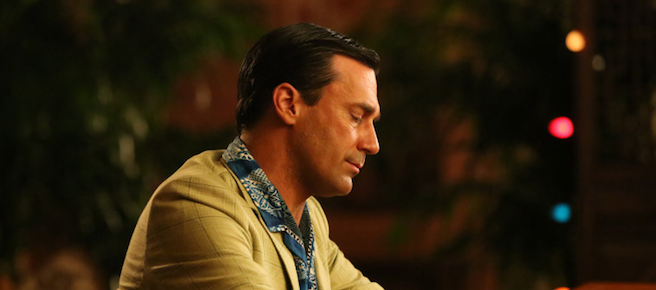Mad Men, Season 6: Something died
Colin Horgan on what went missing in Don Draper’s world
Share

For all the new characters and new offices and new drama, something was missing from Season 6 of AMC’s Mad Men. Though advertising drove the world around the newly named SC&P, we saw little of it being created – or created well, anyway. There was a presentation for the Royal Hawaiian hotel. There was a bit about ketchup. There was some talk about Sunkist and Ocean Spray. And there was that bizarre homage to Rosemary’s Baby for St. Joseph’s. But even still, there was a feeling it wasn’t quite the same in this world – something was gone.
That none of these pitches was particularly successful or inspired might be it. Contrasting the way Don Draper and his team sold ideas in Season 6 to how they sold ideas in Season 1 shows not only how engaged Don used to be in the process of selling the future, but how easily his clients were willing to believe in it. Remember that moment in Season 2 (1962) when Don pitched American Airlines to his own staff, striding out of his office, echoing slightly a young President Kennedy, and announcing to everyone that: “American Airlines is not about the past any more than America is. Ask not about Cuba, ask not about the bomb. We’re going to the moon. Throw everything out.” Paul Kinsey was the one to first reply: “Everything?” he asked. “There is no such thing as American history, only a frontier,” Don replied. It wasn’t about the past, he said. It was about the airline the clients “are going to be running … let’s pretend we know what 1963 looks like.”
http://www.youtube.com/watch?v=N-iWbrT-nvI
They didn’t land the American account, but it was Don’s attitude – his vision of what might be, what could be – that sold so many other things, not only to Sterling Cooper’s clients, but to millions of consumers. It’s how Peggy Olsen learned to be what she is now. “Whatever special properties the Relax-a-cizor are,” she once told Ken Cosgrove, “what we’re selling is confidence, a better you.” A better this, a better that, a better everything just over the horizon.
By 1968, everything has changed. It is that future, and rather than shedding it, America finds it has a past and a history – one that has come around to knock on the doors of places like the Democratic national convention or Harlem. Ask not about Cuba or the bomb; ask now about Vietnam and napalm. America is still going to the moon, but it’s starting to feel like that’s less about finding a new world than it is about escaping the old one.
There still is a horizon, though it is now much closer and looks a lot different than it did in Season 1 or 2. Now, as Season 6 ends, the young guys in creative aren’t looking to emulate their bosses; they want, either secretly or outwardly (think Michael Ginsberg), to destroy them and everything they stand for. Outside, too, the world no longer swoons over advertising, but having read their Adorno and Debord, and soon to read their Baudrillard, is increasingly skeptical of advertising’s veracity, and against its spectacle and assumed cultural consensus. It is a world less convinced of Peggy’s assertion that consumerism was making anyone a better anything. And it is the world that will soon ask for these kinds of messages to be more tightly controlled, more regulated, and will, eight years again into the future, be one in which a majority of poll respondents will feel that “most or all of television advertising was seriously misleading.”
It is little wonder, then, that the horizons Don is selling in 1968, as he did for the Royal Hawaiian, are the kind people step off to certain death.
Which is what we were all waiting for this season. Running through Season 6 was the hint that, as in Season 5, a main character would die. Someone, surely, at some point has to live out the opening credit image of the falling man. Surely, too, everything – the heavy presence of sirens, the Sharon Tate allusions, the ghost of a dead soldier, Don’s near drowning, the season’s promotional poster (with two Don Drapers looking over their shoulders at one another, the police cars in the background), Ken Cosgrove’s run-in with a shotgun – pointed to the death of someone as important as Lane Pryce.
But show creator Matt Weiner is known for his bait-and-switch. The imagery was perhaps all so on-the-nose because what we should have been watching for was not a literal death, nor perhaps even the death of the heyday of advertising, but instead the final throes of America’s postwar innocence (or innocence itself) and the idea that history was drawing to a close and that the Good Guys won. Those good guys were men like Don, who, despite everything could convince each other and everyone else they were helping people become a better version of themselves. Now nobody – not Sally Draper, not Pete Campbell, not those who watched Bob Benson with skepticism – can be sure who the good guys are. Don, too, no longer knows. Most importantly, he no longer knows whether he can still be counted among them.